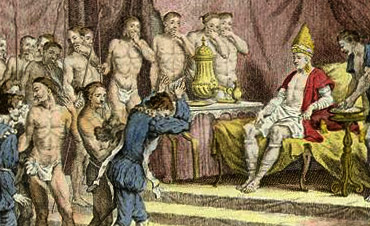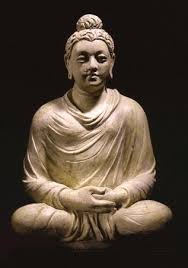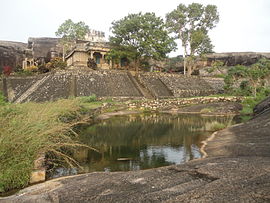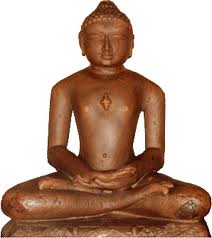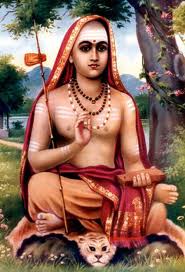Kerala - From 8th to 15th Century
For the ancients in Kerala, the Dravidian form of nature worship was the practise. Jainism had reached Kerala around 3rd century BC and was soon followed by the arrival of Buddhism. As a belief system it influenced a number of rulers in the region and led to the establishment of Jain and Buddhist monasteries. One such relic is the Chitharal Jain temple in south Kerala and others in the Wayanad areas. Unmistakeable influence of Jainism is identifiable in the architectural styles of the Hindus and Muslims in later times, as well as, in the design of temple architecture.
Similarly, Buddhism too found a fertile soil in Kerala and a major Buddhist centre was Sreemoolavilasam where a Buddhist temple stood till the 10th Century. According to historian Prof M Sreedhara Menon, “The Ayurvedic school of medicine was promoted by the Buddhists. Buddhist viharas functioned as free dispensaries offering treatment. Vagabhatta’s treatise on medicine, ‘Ashtaangahridayam’, was also well-received in Kerala. Buddhism played a major role in developing literacy and knowledge in the region.”
With the revival of Chera power between 800-1102 AD under the Kulasekharas of Thiruvanchikulam (Mahodayapuram), Hinduism gained prominence thus relegating Buddhism and Jainism to the background and leading to its decline. The 8th century was witness to the arrival of a large number of Brahmins, thus affecting the demographic profile of the place. A revival and consequently a reunification of Hinduism were further made possible with the Advaita philosophy of Sri Sankaracharya (788-820).
The seer, who was born in Kalady in present day Ernakulam district, based his Advaita philosophy and propounded its tenets based on his analysis of the Upanishads. The approach he adopted gave new meaning and raised Hinduism to a higher plane. He established mutts in the four cardinal points of the subcontinent –Sringeri in the South, Varanasi in the North, Puri in the East and Dwarka in the West. With the acceptance of his principles of Hinduism, the influence of Buddhim and Jainism began to fade out. Many of their places of worship got converted as temples. This transition also saw the rise of Brahmins and their supremacy in the social fabric in Kerala and concurrently triggered the rise of a caste hierarchy,untouchability and inapproachability. Kerala moved ahead with these practices getting entrenched in the system and also the growth of two forms of education for the Brahmins and others. The first major attempt to check this form of discrimination based on caste took place during the freedom struggle.
Beginning of the Malayalam Era in Kerala
The European calendar relies on the BC and AD eras for the timeline of history. In India we have Saptarshi Era -76 B.C., Vikram Era 56 B. C., Saka Era- 78 A.D., Kalpuri Era -248 A.D., Gupta Era – 320 A.D. and Harsha Era – 606 A. D. but the Malayalam calendar has been fixed at 824-825 A. D. and is known as ‘Kollam era’.
There are many theories and explanations regarding this– the year Kollam (Quilon) town was established, the year the Christian communities settled in Kollam, the year of destruction of Kollam by the Cholas and the year Sankaracharya introduced specific rituals and practices-the final word is yet to be said about this. The ‘Kollam’ calendar also has twelve months and 7 day week. This pattern is used to determine auspicious days in the Malayali’s special days, pertaining to religion and agriculture or social events like birth, death, marriage or any other auspicious beginning.
Kerala was under the rule of the Kulashekhara rulers when the Kollam era was adopted in 824-825. The second coming of the Cheras under the Kulashekharas was significant for having exerted its control over the whole area and not in parts as had often been the situation. While some historians counter this claim, documents exist to prove the supremacy of the Kulashekharas between 800-1102. Veteran historian Prof Elamkulam Kunjan Pillai is of the confirmed view that Kerala was behind none at this time in history and had attained social, economic and cultural progress during this period.
In the West there existed at this time four major power centres– Arab rule of Spain with capital at Kurtabbu, the Holy Roman Empire in Italy, the Eastern Roman Empire with Constantinople as headquarters and the Muslim kingdom under the Caliphs of Baghdad.
Traveller’s chronicles that attracted Europeans to India
The West looked towards Kerala after they had read the accounts of travellers and adventurers who had landed here in the 15th century and left their writings for posterity. Suleiman, Al Beruni, Al Idrisi, John of Monte Corvino, Marco Polo, Ibn Batuta, John D’ Marinolli, Nicolo Conti, Mahwanvi are some of the names.
Megasthenes, the ambassador sent by the Greek ruler Seleukos Nikator, acquired a special place in this by writing his account, “Indica” on Chandragupta Maurya’s reign.
The Mauryan rule which saw the rise of Ashoka and master of statecraft –Kautilya, who wrote the “Arthashastra”, came to an end by 185 BC. This was followed by a period of Greek presence followed by the Sakas and Kushanas who came from Central Asia and became part of the local mainstream. Charaka and Shushruta were the ancient men of medicine and surgery. The Golden Age of Ancient India came in the 4th century AD with the rise of the Gupta empire in the Magadha. Chandragupta I (320-380), Samudragupta (330-380), Chandragupta II (380-415) also known as Vikramaditya, were the rulers who shone at that time. Kalidasa, the great dramatist, Aryabhatta, the astronomer-mathematician and Varamamihira, the astronomer-astrologer, had enriched the period’s history.
Fa Hien, the Chinese Buddhist pilgrim who travelled in India between 399-414 AD, did not come to Kerala but his accounts remain significant as regards the Gupta Age and the spread of Buddhism. Accounts of his visit to the Deccan region do have pointers to the Kerala region. Prophet Mohammed’s period is pegged at 569 -632 AD , a phase during which his teachings reached the Arab lands, Asia and Africa, and made a difference to the history of the regions too. Since India had trade ties with the Arabs, the religion also touched this land at the same time. The decline of the Gupta supremacy was followed by the rise of Harshavardha in Kanauj (606-647 AD), a period when the Chinese pilgrim Hiuen Tsang arrived. He spent time at Nalanda which was a centre of learning. His accounts reveal that this place had 8500 students and 1500 teachers. Besides Nalanda, Taxila, Ujjain, Vikramshila, Varanasi and Gaya were established centres of learning. Although Huien Tsang did not visit Kerala, his accounts refer to Kerala. The 9th century traveller Suleiman from the Persian Gulf made many visits to both India and China. An equally informed account of India and Kerala is available in the accounts of Alberuni who came in the 10th century. A learned person, he was interested in a variety of subjects. It is said that he came along with the invading troops of Mahmud of Ghazni.
Alberuni’s accounts furnish details about the wealth and the spices of Kerala, as well as pepper cultivation. Towards the close of the 11th century Al Idriz from the court of the Sicilian ruler Rojan II also threw light on the same aspects. All said and done, it was the accounts of Italian traveller Marcopolo that attracted the travellers and voyagers to the Orient. He came on a mission entrusted by Kublai Khan, the Mongol ruler. Logan’s account mention of Marcopolo having passed through the area in 1292 -93 and makes mention of the black gold that was a major attraction for every outsider and the pearls, corals, gold and the land of beautiful women of the East are also mentioned. Ibn Battuta, the travelling moor from Morocco, D’ Marignelli and Nicolo Conti have all left accounts of Kerala when they chronicled their stay in the country during the first half of the 15th century. Many Emperors in the European continent encouraged travellers to undertake this route to Kerala and India. It was on one such trip that Columbus who set out (1492) for East finally touched the New World and thus discovered America. The landing of Vasco da Gama on the shores of Kappad, near Calicut in 1498 opened the sea route between the Occident and the Orient, a discovery which would have a lasting impact on the future events in the region and history of the world.
The search for new lands with trading interests in mind and later as part of territorial expansion of the European powers led to the rise of colonies. The colonial ambitions of the European powers would mark a new phase in world history: Africa, Asia, Australia and America became lands where the Europeans experimented their territorial ambitions.
15th Century Kerala-India
During the close of the 15th century when Vasco da Gama landed in Kerala, Europe was going through the Renaissance which was an era of discoveries in Science and era of literary, artistic and cultural efflorescence. It was against this background that Christopher Columbus, who left Spain with the royal patronage of King Ferdinand and Queen Isabella, took a route that led him to the American continent instead of India which was the intended destination. Till his death in 1506 he believed that he had landed in India. Six years later when Vasco da Gama touched India, France and Britain were prompted to give fresh thrust to their colonial expansion, because Portugal and Spain had already moved across the oceans. New discoveries of land went side by side with the new knowledge that came with Renaissance in Europe – where literature, arts, science and education were making giant leaps.
It was 53 years after Gutenberg’s invention of the printing machine that Vaso da Gama reached India. Leonardo da Vinci, Michael Angelo and Copernicus were the brilliant minds who gave the period its aura.
India at the time of Vasco da Gama’s visit had already come under the rule of invading Muslim groups: Slave dynasty -1206-1290, Khiji 1290-1320, Tughlak 1320-1412, Sayyid 1412-1451, Lodi 1451-1526 – were the dynasties that held sway over the parts of India (sometimes as far as the Deccan) during these centuries. It was the alienated general of Ibrahim Lodi and Daulat Khan Lodi, the governor of Punjab, who invited Babar from Kabul to attack the Lodi ruler. A major milestone of India’s history is the Battle of Panipat in 1526 where Babar’s troops trounced Ibrahim Lodi and established the Mughal Empire which held sway for two centuries. The south was under the Hindu kings of Vijayanagar and Muslim Bahmani rulers. When Vasco da Gama landed in Kerala, there was no unified rule but scattered feudatory states. It was the second coming of the Chera rule under the Kulasekhara clan that a unified control over this geography happened.
Kollavarsha aarambhathil in ‘Selected Writings of Elamkulam Kunjan Pillai’ - Ed by K N Sam, Published by International Study Centre, Kerala University, Kariyavattom (2005)
